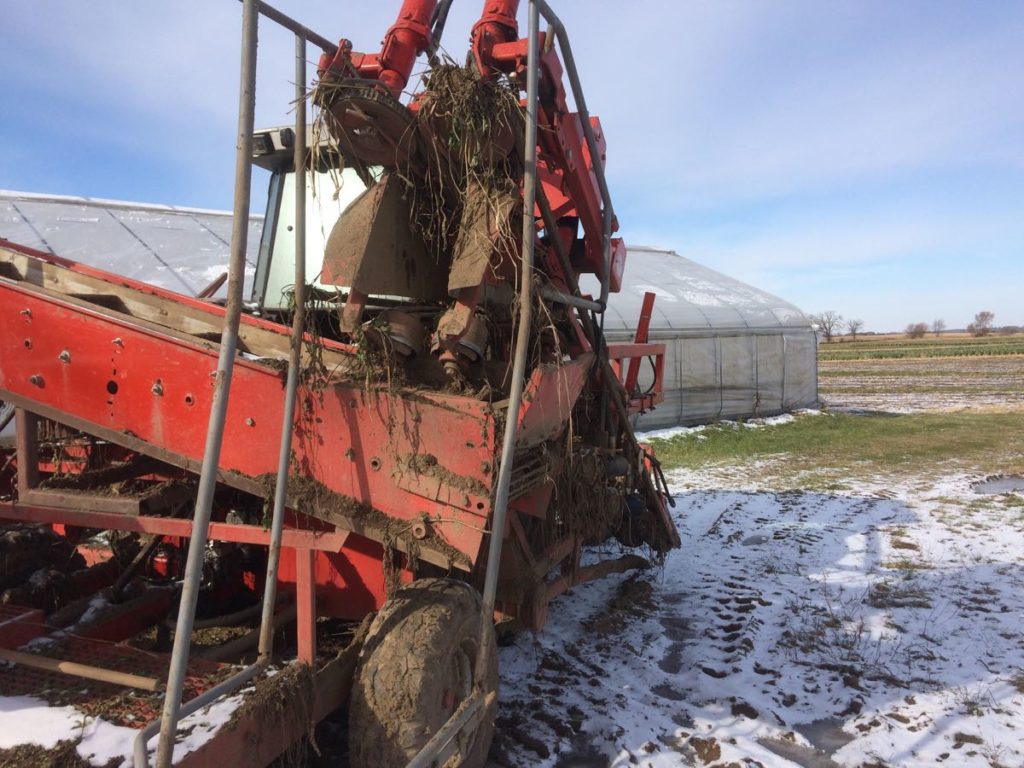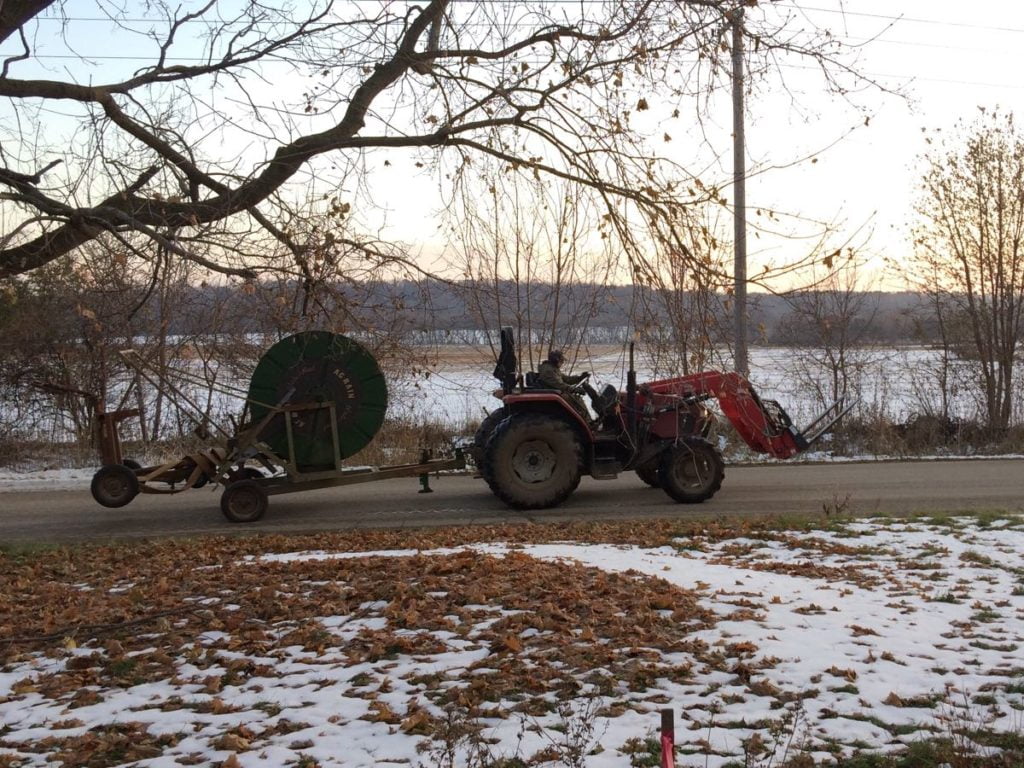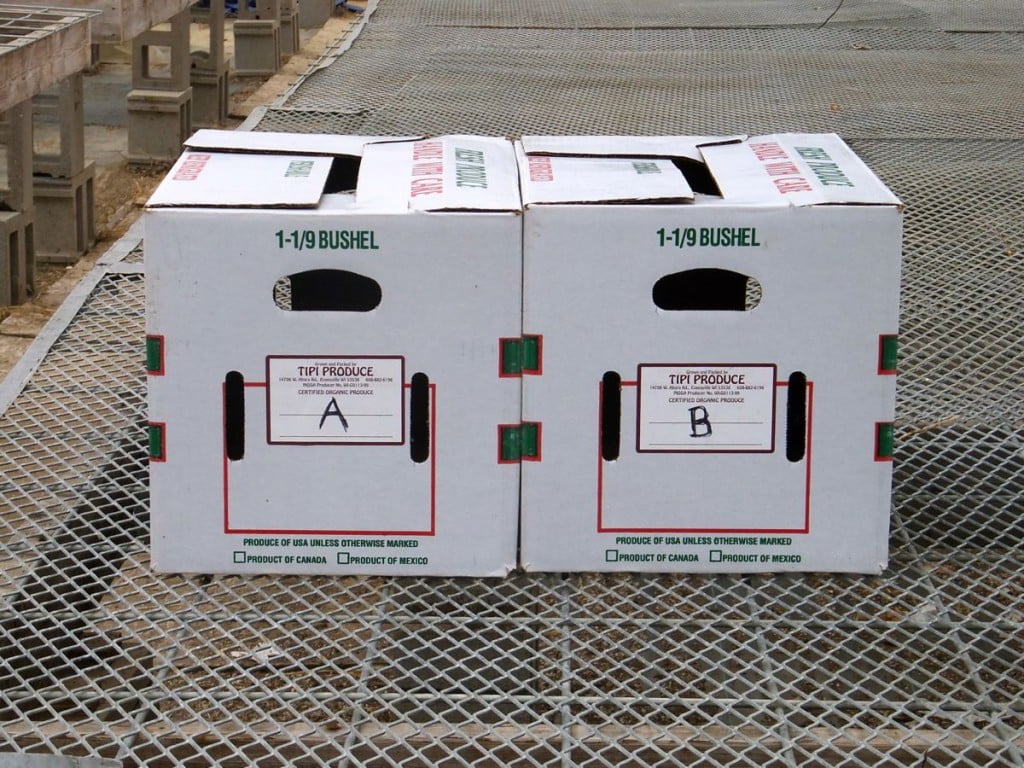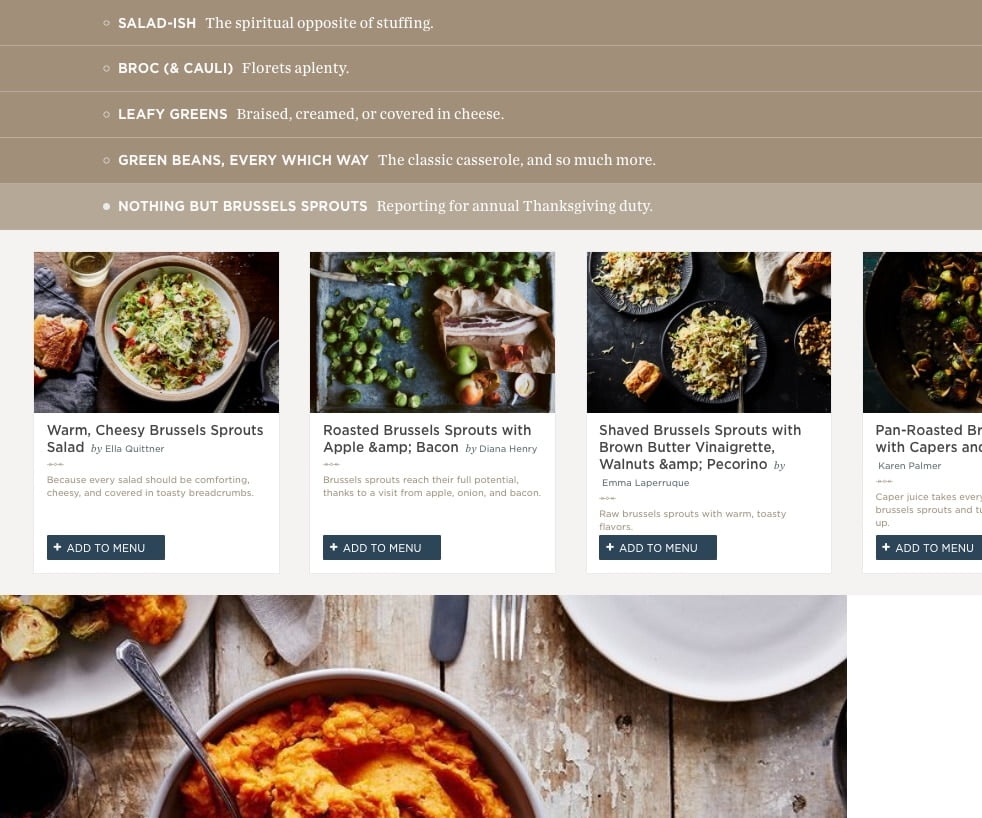Storage Share, Nov. 21/22, 2019
- On: November 20, 2019
 0
0

We ended the season with all our equipment covered in mud, including this very muddy carrot harvester.

Steve takes our irrigator to overwinter in the neighbor’s shed. It didn’t get much use this year.
Our season is DONE. Often, we’re still harvesting in November but the cold weather ended our outdoor work. We are very grateful for the recent warm-up. It makes everything easier, including getting this Storage Share ready. The warmer weather has given us a chance to clean equipment before putting it away in storage until spring. We worried that we’d have to put everything away covered in mud.
Now we look forward to winter, with lots of cooking, ice skating and skiing (we hope!) before planning next season. Have a wonderful Thanksgiving! Beth & Steve
Storage Share this week

Take one box labelled “A” and one box labelled “B”.
Things you need to know about your winter share
* Your delivery will consist of two different boxes, labeled “A” and “B”. Take one “A” box and one “B” box. The boxes contain different vegetables.
* Please pick up your boxes on the day of delivery, during the normal hours for your site.
* Outpost members, pick up your boxes on Friday. This is the busiest weekend of the year for the Outpost staff, so they WILL NOT hold boxes past Friday, nor can they handle special requests.
* Members at unheated sites, please replace the blankets carefully. That keeps everyone’s produce in good shape.
* Bring lots of bags to take your produce home. It’s a lot of produce!
Veggie List and Storage Info (Storage share, Nov. 21/22, 2019)
We hope you enjoy this shipment of veggies. Strategize to use them well, as some will last longer than others.
* These are the most perishable vegetables: kale, the green parts of the leeks
* These are the next-most perishable: Brussels sprouts, cabbage, the white parts of the leeks, and onions. Keep an eye on your butternut, potatoes and sweet potatoes. The last two are susceptible to drying out. Expect the largest butternuts to last the longest.
* These will last the longest: daikon radish, beets, carrots, celeriac, garlic, parsnips.
Box “A”
Refrigerate everything in this box.
Beets, 3 lb
Brussels sprouts, on stalks
Carrots, 6 lb total
….. orange ~4 lb
….. yellow & purple ~2 lb
Celeriac, 1
Daikon winter radishes, several
Green cabbage, 1 medium or 2 small
Kale “garnish”
Leeks, ~3 lb
Parsnips, ~3 lb
Box “B”
The Brussels sprouts need refrigeration. Everything else in this box can be stored cool or at room temperature. See notes below for more detail.
One more Brussels sprouts stalk
Butternut squash, 9 – 10 lb
Garlic, 3 bulbs
Onions, 5 lb total
….. ~1 lb red
….. ~4 lb yellow
Potatoes, russet, 5 lb
Potatoes, Satina, 5 lb
Shallots, 2
Sweet potatoes, ~10 lb
Beets – Refrigerate in a bag or container. Beets will store for two months or longer.
Brussels sprouts – Pluck from stalks and refrigerate in a bag or container. Do this the day you pick up your CSA boxes. Eat within 2 to 3 weeks.
Butternut winter squash – You will receive ~9 lbs of squash. Store your butternut in a cool, dry place. 60 F is ideal. Do not put in a plastic bag. Expect the largest butternuts to store the longest. Inspect your squash frequently and cook promptly if you see any soft spots developing. You can cook, mash and freeze the squash for future use. I find that you can refrigerate cut raw squash for up to one week. This runs counter to the accepted way to store squash, but is useful if you want to cook just half a squash. Try microwaving your squash for one to two minutes before cutting or peeling. This softens the squash and makes a large butternut easier to handle.
Cabbage – Refrigerate.
Carrots, orange. Refrigerate in a plastic bag. Will keep for several weeks.
Carrots, yellow & purple. These varieties are pretty AND they taste good.
Celeriac – Will store for months in your fridge. Cut off chunks as needed. Peel before using. I find it easiest to cut the celeriac into flat slices, then peel.
Daikon radishes (oblong, white or purple) – Refrigerate. The interior color of the purple ones is lovely. Slice thinly and add to salads, cook lightly in mixed vegetable medleys or cut into matchsticks and add to pasta salads. We enjoy grated carrot and daikon salads all winter.
Garlic – Store at room temperature.
Kale – It is tiny. We rarely send something so small. However, that was the last thing our crew harvested on a cold, dim, muddy day. They were so proud of what they accomplished that now we have to use it. Tuck it in a dish or use it as a garnish. The crew brainstormed and they think it would make a great corsage for the Thanksgiving cook in your household. Storage: Refrigerate and use soon.
Leeks. The bottoms (white part) will store longer than the tops (green and pale-green parts). We suggest that you cut off and use the tops first. It’s unconventional but you’ll be able to store the bottoms for longer. In general, leeks are not a long-storage crop. You may need to strip off one or two outer leaves to freshen the leeks before you cook them.
Onions: Refrigerate or store in a cool, dark spot and protect from light. Exposure to light stimulates sprouting. If you have the room, it’s safer to store the onions in the refrigerator. After the wet fall, they might not last as long as usual.
Parsnips (These look like large white carrots.) – Refrigerate in a plastic bag. Parsnips will store for several months but will darken in color. That is a harmless change.
Potatoes; russets and Satinas – Can be stored at room temperature or in a cool spot, but must be kept in the dark so they do not turn green. A cloth or loose plastic bag draped over the paper bag will slow moisture loss, but do not close the plastic bag. Both types will store longer if kept cool. Around 40 – 50 F is ideal. The potatoes were grown by the Igl family near Antigo.
Russets– We got the big ‘baking’ grade so you have nice bakers for Thanksgiving. Excellent for baked or mashed potatoes.
Satinas– These are good all-purpose potatoes, everything from roasted to potato salad. I really like this variety of yellow potato because they oven-roast so well and because they are less sweet than other yellow varieties such as Yukon Golds.
Shallots (look like small red onions) – Good for salad dressing.
Sweet potatoes – These are the Covington variety, with excellent flavor and sweetness. Store at room temperature, no lower than 55 F, but 60+ F is better. Keep them on your kitchen counter where it’s easy to keep an eye on them. I like to keep ours in a paper bag so they don’t dehydrate. Cook promptly if they start to soften. The roots come in a wide ranges of sizes and all are good.
Recipe Ideas
I will not try to sway your Thanksgiving menus. I bet you have your dishes chosen, perhaps based on family tradition. However, this is a great time of year to gather recipes to enjoy all winter. You should peruse online cooking sites while they are feature Thanksgiving menus, many of which are suited to your Storage share vegetables. Bookmark the recipes soon; Thanksgiving collections are taken down quickly after the holiday. I have a huge list of recipes bookmarked to delve into this winter.

One small corner of Food52’s Thanksgiving Menu Maker.
♦ Once again, the lively Food52.com site has outdone itself with a fantastic Thanksgiving recipe collection. They call it their “AutoMagic Thanksgiving Menu Maker“. It’s organized by type of dish, e.g.
. “Gratins; Lots of creamy layers,” and
. “Veggie Packed Stuffing; Bring on the fall bounty”, and
. “Nothing but Brussels sprouts; Reporting for Thanksgiving Duty.”
Section #6 (“Orange Sides”) is extensive. I’m gathering a suite of recipes to try this winter. First stop will be “The Absolute Best—& Worst—Way to Make Mashed Potatoes, According to So Many Tests.” The tag line is “I spent 14 hours alone with only potatoes, and I did it for you.” Yes, they are amusing.
♦ Smitten Kitchen is our go-to site for dessert recipes but has excellent veggie recipes too. You can follow her Thanksgiving preparations or go straight to an amazing list of Thanksgiving recipes from previous years. I’m itching to try her Roasted Cabbage with Walnuts and Parmesan recipe.
♦ The Dishing Up the Dirt site doesn’t have a specific Thanksgiving section, but many of her recipes are tailored to Storage share produce.
♦ Halfbaked Harvest has appealing dinner and salad ideas, and gorgeous food photos.
♦ Finally, remember that we can use Local Thyme recipes all winter. Check them out for Thanksgiving ideas.



